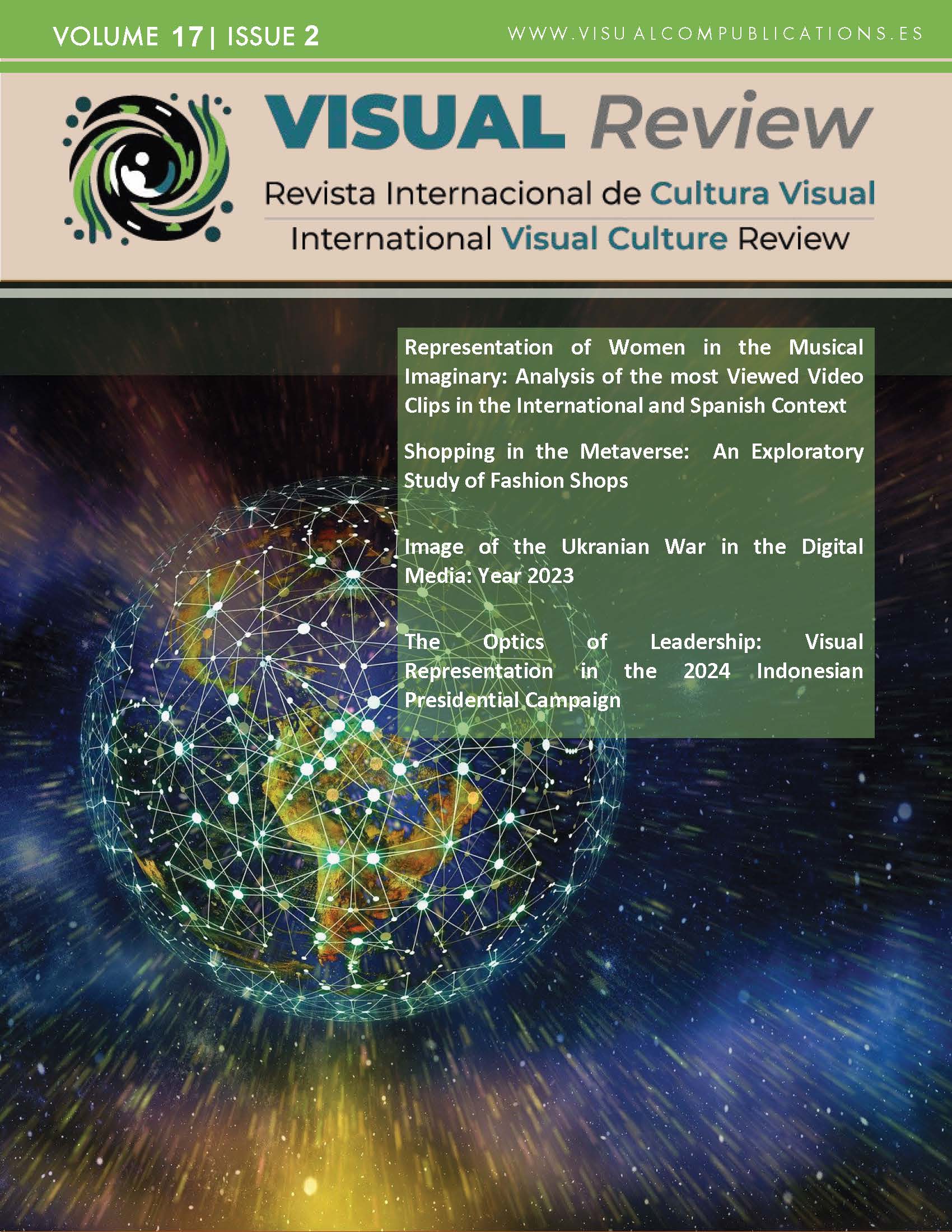The Optics of Leadership
Visual Representation in the 2024 Indonesian Presidential Campaign
DOI:
https://doi.org/10.62161/revvisual.v17.5273Keywords:
Visual representation, Presidential Election Campaigns, Electability, Visual Communication, National LeadershipAbstract
This research explores the significant role played by visual representation in Indonesian presidential election campaigns. By addressing a gap in existing literature that has largely overlooked the importance of visual representation in shaping voter preferences, this study contributes to a deeper comprehension of the underlying dynamics. Through the analysis of visual data, it becomes apparent that effective visual representation has the potential to enhance a candidate’s image, sway voter emotions, and ultimately impact electability. Key findings highlight variations in communication strategies employed by presidential candidates, emphasizing the crucial role of visual representation in political campaigns and the complex array of factors influencing public decision-making. The dominance of visual communication emerges as a critical factor in shaping public opinion and determining voter preferences. This study provides scholarly insights into the mechanisms involved in visual communication within political processes, particularly within the context of leadership campaigns.
Downloads
Global Statistics ℹ️
|
859
Views
|
812
Downloads
|
|
1671
Total
|
|
References
Aguilar, H. G. (2023). The political hate speech in the last Peruvian presidential election. VISUAL REVIEW. International Visual Culture Review / Revista Internacional de Cultura Visual, 13(2), 1–15. https://doi.org/10.37467/revvisual.v10.456 DOI: https://doi.org/10.37467/revvisual.v10.4562
Arifiyanti, A. A., Wahyuni, E. D., & Kurniawan, A. (2020). Emotion Mining of Indonesia Presidential Political Campaign 2019 using Twitter Data. Journal of Physics: Conference Series, 1569(2), 022035. https://doi.org/10.1088/1742-6596/1569/2/022035 DOI: https://doi.org/10.1088/1742-6596/1569/2/022035
Boulianne, S. (2019). Revolution in the making? Social media effects across the globe. Information, Communication & Society, 22(1), 39–54. https://doi.org/10.1080/1369118X.2017.1353641 DOI: https://doi.org/10.1080/1369118X.2017.1353641
Braun, V., & Clarke, V. (2006). Using thematic analysis in psychology. Qualitative research in psychology, 3(2), 77-101. DOI: https://doi.org/10.1191/1478088706qp063oa
Coe, K., & Reitzes, M. (2010). Obama on the Stump: Features and Determinants of a Rhetorical Approach. Presidential Studies Quarterly, 40(3), 391–413. doi: https://doi.org/10.1111/j.1741-5705.2010.03777.x DOI: https://doi.org/10.1111/j.1741-5705.2010.03777.x
Cerdán-Martínez, V., Bárcena, S., & Villa-Gracia, D. (2020). The Popularity of Biden and Trump in the United States and Latin America during the 2020 Campaign: A study through Google Trends. Visual Review, 16(2), 181–92. https://doi.org/10.62161/revvisual.v16.5211 DOI: https://doi.org/10.62161/revvisual.v16.5211
Conners, J. L. (2005). Visual Representations of the 2004 Presidential Campaign: Political Cartoos and Popular Culture References. American Behavioral Scientist, 49(3), 479–87. https://doi.org/ 10.1177/0002764205280920 DOI: https://doi.org/10.1177/0002764205280920
Denzin, N. K., & Lincoln, Y. S. (Eds.). (2011). The Sage handbook of qualitative research. sage.
Firdaus, A. A., Yudhana, A., Riadi, I., & Mahsun, M. (2024). Indonesian presidential election sentiment: Dataset of response public before 2024. Data in Brief, 19(52), 109993. https://doi.org/10.1016/j.dib.2023.109993 DOI: https://doi.org/10.1016/j.dib.2023.109993
Gaumont, N., Panahi, M., & Chavalarias, D. (2018). Reconstruction of the socio-semantic dynamics of political activist Twitter networks—Method and application to the 2017 French presidential election. PLOS ONE, 13(9), https://doi.org/10.1371/journal.pone.0201879 DOI: https://doi.org/10.1371/journal.pone.0201879
Geise, S., Maubach, K., & Eli, A. B. (2024). Picture me in person: Personalization and emotionalization as political campaign strategies on social media in the German federal election period 2021. New Media & Society. https://doi.org/10.1177/14614448231224031 DOI: https://doi.org/10.1177/14614448231224031
Griffin, M., & Kagan, S. (1996). Picturing culture in political spots: 1992 Campaigns in Israel and the United States. Political Communication, 13(1), 43–61. https://doi.org/10.1080/10584609.1996.9963094 DOI: https://doi.org/10.1080/10584609.1996.9963094
Herawati, R., & Sukma, N. M. (2019). Negative Campaign Presidential Election 2019 on Indonesia National Integration. International Journal of Scientific and Technology Research, 8(11), 1994–1997.
Jayawardena, L. (2017). Impact of internet and social networks on the final result of 2016 presidential election of the United States. 2017 National Information Technology Conference (NITC), 80–85. http://dx.doi.org/10.1109/NITC.2017.8285651 DOI: https://doi.org/10.1109/NITC.2017.8285651
Jude, S. (2024). Fauda and the Israeli occupation of Palestine: Gender, emotions, and visual representations of complicity in international politics. Review of International Studies, 50(1), 107–26. https://doi.org/10.1017/S0260210522000651 DOI: https://doi.org/10.1017/S0260210522000651
Khosronejad, P. (2011). Some Observations on Visual Representations of the 2009 Iranian Presidential Election Crisis. Iranian Studies, 44(3), 395–408. https://doi.org/10.1080/00210862.2011.556391 DOI: https://doi.org/10.1080/00210862.2011.556391
Liebhart, K., & Bernhardt, P. (2017). Political Storytelling on Instagram: Key Aspects of Alexander Van der Bellen’s Successful 2016 Presidential Election Campaign. Media and Communication, 5(4), 15–25. https://doi.org/10.17645/mac.v5i4.1062 DOI: https://doi.org/10.17645/mac.v5i4.1062
Lull, J. (2009). Media, Communication, Culture: A Global Approach. Columbia: Columbia University Press.
Matas, P. M., & Gil, Í. (2024). Comunicación visual y discurso narrativo en redes sociales. VISUAL REVIEW. International Visual Culture Review / Revista Internacional de Cultura Visual, 16(1), 211–224. https://doi.org/10.62161/revvisual.v16.5204 DOI: https://doi.org/10.62161/revvisual.v16.5204
Miles, M. B., & Huberman, A. M. (1994). Qualitative data analysis: An expanded sourcebook. sage.
Norris, P. (2001). A Virtuous Circle? The Impact of Political Communications in Post-Industrial Democracies. In Dowding, K., Hughes, J., Margetts, H. (Eds), Challenges to Democracy (pp. 100–117). London: Palgrave Macmillan UK. https://doi.org/10.1057/9780230502185_7 DOI: https://doi.org/10.1057/9780230502185_7
Panda, S., & Roy, S, T. (2021). Comparing Voter Electoral Preferences Using Visualizations. The International Journal of Visual Design, 15(2), 57–66. https://doi.org/10.18848/2325-1581/CGP/v15i02/57-66 DOI: https://doi.org/10.18848/2325-1581/CGP/v15i02/57-66
Pospíšilová, J. (2023). Who is mobilized by the presidential election? Acta Politologica, 15(3), 31–46. https://doi.org/10.14712/1803-8220/17_2023 DOI: https://doi.org/10.14712/1803-8220/17_2023
Qadir, E. M. (2023). Visual Rhetoric in Election Posters. A Multimodal Critical Discourse Analysis Approach. Koya University Journal of Humanities and Social Sciences, 6(1), 136–59. https://doi.org/10.14500/kujhss.v6n1y2023.pp136-159 DOI: https://doi.org/10.14500/kujhss.v6n1y2023.pp136-159
Sahlan, M. (2023). Digital Theocracy Strategy in the 2024 Presidential Election Campaign: Its Influence on Public Opinion and Voter Choice. Eduvest - Journal of Universal Studies, 3(10), 1883–1891. https://doi.org/10.59188/eduvest.v3i10.936 DOI: https://doi.org/10.59188/eduvest.v3i10.936
Sanina, A. (2019). “Who Are You Kidding?”: Visual Political Irony in Contemporary Russia. Qualitative Inquiry, 25(4), 432–444. https://doi.org/10.1177/1077800418790292 DOI: https://doi.org/10.1177/1077800418790292
Satria, I., Kurnia, A., & Nurhadryani, Y. (2014). Influence of presidential candidates e-campaign towards voters in 2014 presidential election in Bogor City. 2014 International Conference on Advanced Computer Science and Information System, 90–95. http://dx.doi.org/10.1109/ICACSIS.2014.7065874 DOI: https://doi.org/10.1109/ICACSIS.2014.7065874
Sazan, D, Al-Smadi, O. A., & Rahman, N. A. (2024). Visual Representation of Malaysian Candidates in General Election in Selected Coalition Parties: A Visual Survey on Social Media. Theory and Practice in Language Studies, 14(2), 365–75. https://doi.org/10.17507/tpls.1402.07 DOI: https://doi.org/10.17507/tpls.1402.07
Scheufele, D. A. (2000). Agenda-Setting, Priming, and Framing Revisited: Another Look at Cognitive Effects of Political Communication. Mass Communication and Society, 3(2–3), 297–316. https://doi.org/10.1207/S15327825MCS0323_07 DOI: https://doi.org/10.1207/S15327825MCS0323_07
Shim, D., & Nabers, D. (2013). Imaging North Korea: Exploring its Visual Representations in International Politics. International Studies Perspectives, 14(3), 289–306. https://doi.org/10.1111/j.1528-3585.2012.00493.x DOI: https://doi.org/10.1111/j.1528-3585.2012.00493.x
Soliman, N. E., & Osama, A. M. (2022). US Presidential Elections on Social Media: Uses and Dependency Model. International Journal of Sociotechnology and Knowledge Development, 14(1), 1–15. https://doi.org/10.4018/IJSKD.297977 DOI: https://doi.org/10.4018/IJSKD.297977
Tufekci, Z. (2018). How social media took us from Tahrir Square to Donald Trump. MIT Technology Review. https://www.technologyreview.com/2018/08/14/240325/how-social-media-took-us-from-tahrir-square-to-donald-trump/
Yulfa, R. I., Setiawan, B. H., Lourensius, G. G., & Purwandari, K. (2023). Enhancing Hate Speech Detection in Social Media Using IndoBERT Model: A Study of Sentiment Analysis during the 2024 Indonesia Presidential Election. ICCA 2023 - 2023 5th International Conference on Computer and Applications. http://dx.doi.org/10.1109/ICCA59364.2023.10401700 DOI: https://doi.org/10.1109/ICCA59364.2023.10401700
Downloads
Published
How to Cite
Issue
Section
License
Copyright (c) 2025 VISUAL REVIEW. International Visual Culture Review / Revista Internacional de Cultura Visual

This work is licensed under a Creative Commons Attribution-NoDerivatives 4.0 International License.
Those authors who publish in this journal accept the following terms:
-
Authors retain copyright.
-
Authors transfer to the journal the right of first publication. The journal also owns the publishing rights.
-
All published contents are governed by an Attribution-NoDerivatives 4.0 International License.
Access the informative version and legal text of the license. By virtue of this, third parties are allowed to use what is published as long as they mention the authorship of the work and the first publication in this journal. If you transform the material, you may not distribute the modified work. -
Authors may make other independent and additional contractual arrangements for non-exclusive distribution of the version of the article published in this journal (e.g., inclusion in an institutional repository or publication in a book) as long as they clearly indicate that the work was first published in this journal.
- Authors are allowed and recommended to publish their work on the Internet (for example on institutional and personal websites), following the publication of, and referencing the journal, as this could lead to constructive exchanges and a more extensive and quick circulation of published works (see The Effect of Open Access).













